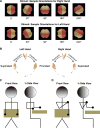Preserved grip selection planning in chronic unilateral upper extremity amputees
- PMID: 21863261
- PMCID: PMC4978427
- DOI: 10.1007/s00221-011-2842-5
Preserved grip selection planning in chronic unilateral upper extremity amputees
Erratum in
- Exp Brain Res. 2014 Jan;232(1):345-6
Abstract
Upper limb amputees receive no proprioceptive or visual sensory feedback about their absent hand. In this study, we asked whether chronic amputees nevertheless retain the ability to accurately plan gripping movements. Fourteen patients and matched controls performed two grip selection tasks: overt grip selection (OGS), in which they used their intact hand to grasp an object that appeared in different orientations using the most natural (under- or overhand) precision grip, and prospective grip selection (PGS), in which they selected the most natural grip for either hand without moving. We evaluated planning accuracy by comparing concordance between grip preferences expressed in PGS vs. OGS for the intact hand and PGS vs. the inverse of OGS responses for the affected hand. Overall, amputees showed no deficits in the accuracy of grip selection planning based on either hand and a consistent preference for less awkward hand postures. We found no evidence for a speed-accuracy tradeoff. Furthermore, selection accuracy did not depend on phantom mobility, phantom limb pain, time since amputation, or the residual limb's shoulder posture. Our findings demonstrate that unilateral upper limb amputees retain the ability to plan movements based on the biomechanics of their affected hand even many years after limb loss. This unimpaired representation may stem from persistent higher-level activity-independent internal representations or may be sustained by sensory feedback from the intact hand.
Conflict of interest statement
Figures








References
Publication types
MeSH terms
Grants and funding
LinkOut - more resources
Full Text Sources
Medical

